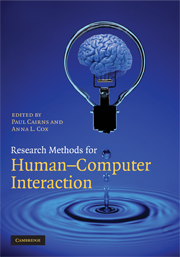Book contents
- Frontmatter
- Contents
- List of figures
- List of tables
- List of contributors
- Preface
- 1 Controlled experiments
- 2 Questionnaires, in-depth interviews and focus groups
- 3 Eyetracking in HCI
- 4 Cognitive modelling in HCI research
- 5 Formal analysis of interactive systems: opportunities and weaknesses
- 6 Using statistics in usability research
- 7 A qualitative approach to HCI research
- 8 Methodological development
- 9 Theoretical analysis and theory creation
- 10 Write now!
- 11 Applying old research methods to new problems
- References
- Index
1 - Controlled experiments
Published online by Cambridge University Press: 05 April 2016
- Frontmatter
- Contents
- List of figures
- List of tables
- List of contributors
- Preface
- 1 Controlled experiments
- 2 Questionnaires, in-depth interviews and focus groups
- 3 Eyetracking in HCI
- 4 Cognitive modelling in HCI research
- 5 Formal analysis of interactive systems: opportunities and weaknesses
- 6 Using statistics in usability research
- 7 A qualitative approach to HCI research
- 8 Methodological development
- 9 Theoretical analysis and theory creation
- 10 Write now!
- 11 Applying old research methods to new problems
- References
- Index
Summary
Overview
Controlled experiments, an approach that has been adopted from research methods in psychology, feature large in the arsenal of HCI research methods. Controlled experiments are a widely used approach to evaluating interfaces (e.g. McGuffin and Balakrishnan, 2005) and styles of interaction (e.g. Moyle and Cockburn, 2005), and to understanding cognition in the context of interactions with systems (e.g. Li et al., 2006). The question they most commonly answer can be framed as: does making a change to the value of variable X have a significant effect on the value of variable Y? For example, X might be an interface or interaction feature and Y might be time to complete task, number of errors or users' subjective satisfaction from working with the interface. Controlled experiments are more widely used in HCI research than in practice, where the costs of designing and running a rigorous experiment typically outweigh the benefits.
The purpose of this chapter is to outline matters that need to be considered when designing experiments to answer questions in HCI.
The method
We have structured this section about how to design and run a controlled experiment in the order that the information is usually reported within the method section of a paper or project report; that is, first we will consider how to go about choosing the participants who will take part in the experiment before moving on to consider designing the experiment itself, assembling the materials and apparatus required, and finally the procedure.
- Type
- Chapter
- Information
- Research Methods for Human-Computer Interaction , pp. 1 - 16Publisher: Cambridge University PressPrint publication year: 2008
- 7
- Cited by



